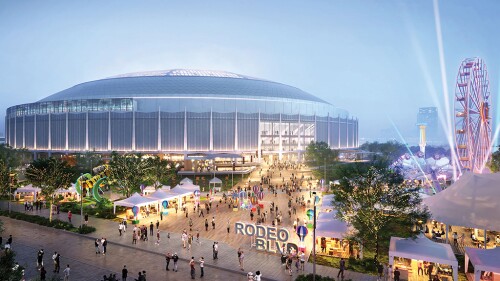Small cities that have been become suburbs of larger ones often have city centers that have waned—and city governments that seek to revitalize them with mixed uses. If these city centers do not have existing viable retail cores, the introduction of the kinds of retail shops that mix with more urban housing becomes difficult.
Retailers are reluctant to open stores in places without a critical mass of other stores and shoppers. Retail space built under housing is more difficult and expensive to develop than either space alone. Lenders are especially wary of having vacant stores below rental housing. Housing developers are reluctant to hold, lease, and operate small retail spaces that are peripheral to their principal development business. Retail spaces must comply with more stringent zoning and building code requirements, require more durable materials and storefronts, and cost more to build. And architects strain to accommodate both the taller ceiling heights and parking requirements associated with retail space and the predominant housing components in such projects. Residential units on ground floors also face additional challenges with limited privacy and security at grade level.
Now architects at Dallas-based JHP Architecture/Urban Design have convinced developers and city agencies in two suburban cities in the Dallas/Fort Worth metropolitan area to experiment with a more flexible model for at-grade residential space that can more easily be converted to retail use as the market matures over a longer time frame.
5th Street Crossing
High Street Residential, a subsidiary of Dallas developer Trammell Crow Company, and Garland, an older city of 230,000 people 12 miles (19 km) northeast of Dallas, developed what is now known as Oaks 5th Street Crossing, a transit-oriented development (TOD) project on a 2.75-acre (1.1 ha) downtown site on the block just northwest of the city hall and only 300 feet (91 m) from the Downtown Garland station of the Dallas Area Rapid Transit (DART) light-rail line. The project, now owned by Oaks Properties, is directly west of the Granville Arts Center and close to the Nicholson Memorial Library System’s Central Library and Richland Community College’s Garland campus.
The public/private partnership developed 189 rental residential units and a 330-space shared parking structure. The 200-foot-long (60 m) parking facility runs east–west in the center of the site with two linear 60-foot-wide (18 m) parking bays juxtaposed on opposing sloped floors to accommodate circulation. That orientation reduced the width of the parking entrance to 30 feet (9 m) so as to minimally interrupt the retail space built to activate Fifth Street. The three levels of residential units line the periphery of the site, with the parking structure dividing the site into two internal courtyards, one with a swimming pool.

The problem of small initial retail demand was solved by reducing the depth of retail space to 30 feet (9 m), less than half the building depth, with residential units filling the other half and opening onto the internal courtyards. The shallow depths also shielded the parking structure from view. (Mark Olsen)
The planning and design problem was that the periphery of the site provides frontage for more than 1,300 linear feet (400 m) of retail shops at grade level. With an apartment building depth of 70 feet (21 m), that creates more than 90,000 square feet (8,400 sq m) of potential retail space—more than the location and market can support. At the same time, while the retail market develops, more than 85 percent of the ground-level space would need to be filled by residential units, with all the security and privacy challenges confronting such space, before it could be converted to retail use at some uncertain time in the future. The developer believed that the market could support less than 12,000 square feet (1,100 sq m) of retail space at the time of completion.
Part of JHP’s solution was to reduce the depth of retail space to 30 feet (9 m), less than half the building depth, with residential units filling the other half and opening onto the internal courtyards. Furthermore, the firm concentrated retail space along Fifth Street across from the Granville Arts Center. The shallow depths also shielded the parking structure from view.
Transition from the Street
JHP saw the main challenge being managing a seamless transition of spaces from the public realm of the street to a semipublic realm of the sidewalk to a private realm of the shop or a residence. Ground-floor retail space would provide a superior interface with the community and give the building an active and lively presence at the street.
At the street edge, the firm designed diagonal parking spaces interrupted frequently by 20-foot-long (6 m) planting islands. Accessible, convenient short-term parking is important for retailers and creates a protective barrier from the automobile traffic on the street. Next, 15 feet (4.6 m) of hardscape and landscape was provided to reinforce the urban edge and to allow al fresco café dining and pedestrian movement. Older retail districts usually do not have that much transition space, but suburban redevelopment, with more room to work with, can enhance such space to make it more attractive for shoppers, diners, and residents.
While such a hierarchy of diagonal parking, landscape, and hardscape can work for retailers, the larger question is whether it can also work for initial residential use of those smaller retail units. In a traditional garden apartment complex, JHP contends, residents feel more secure with strict separation between the public and private realms, but in more urban areas, ground-floor residential space normally cannot provide such separation. JHP believes that strict separation is not a viable concept in urban projects because the private and semipublic realms must interact with the street to allow residents to fully realize the benefits of living in a vibrant mixed-use urban neighborhood.
But would the convenience and protection of on-street diagonal parking along with semipublic hardscape and landscape be enough to ensure privacy and safety for residents? In order to enhance this potential, JHP resorted to a number of techniques in its two projects. Some doorways to the spaces were elevated and are reached by short stairs and stoops. Store windows were reduced in size to a more residential scale. Foundation planters were sited to create more private separations for the spaces from each other and from the street. Street furniture was used to direct pedestrian traffic closer to the curb. One wonders whether small entry courtyards could have been used in a manner similar to that at Manhattan brownstone buildings.
While these exterior modifications can help make ground-floor units more attractive to residents, the fact they are on the ground floor has its own appeal. For example, residents and their pets can reach units and parking without having to use an elevator. Home offices are more accessible to daytime visitors. Ground-floor spaces can have significantly taller ceilings, which might accommodate small loft spaces and, when the market improves, retail conversion. Floors can be solid concrete, lending more permanence and providing more choices for floor finishes for residents. Balconies of units on the second floor can provide covered arcades for ground-floor units.
Retail in Flexible Sizes
Another problem with convertible retail or residential space is its size. Not all retailers can fit into a space that can accommodate a small residential unit. Others may need the flexibility to expand if they do well, or to contract if they do not. Fixed demising walls can unduly constrain needed flexibility. JHP provided flexibility by building retail units in modular sizes that can expand or contract while still fitting in with the housing modules above. They determined that neighborhood-scale, flexible retail spaces could share a 30-foot (9 m) depth and be built in modular frontage widths of 24, 36, and 48 feet (7, 11, 15 m). These 720-, 864-, and 1,420-square-foot (67, 80, 132 sq m) sizes could accommodate most prospective retail tenants while being more attractive for developers, retailers, and communities because they offer lower rents, require less parking, and integrate well into a mixed retail/residential development that seeks to cater to the smaller service, café, and specialty businesses that residents hope will serve their urban neighborhoods.
Building at such small sizes can incorporate strategies to reduce costs for design, construction, and tenant improvements. Retail construction costs rise with the use of steel structures or elevated concrete podium designs that are common in urban mixed-use buildings. JHP devised a method to use only less-expensive wood-frame construction. The parking at Oaks 5th Street Crossing is in a central bar structure that has no housing above or retail below, lowering fire protection and ventilation costs. JHP designed the structures using strategically placed engineered wood beams and columns to create open and flexible retail spaces within the modules while significantly reducing construction cost. In addition to increasing permissible spans, the depth of the engineered wood members can allow space for air intake equipment for retail spaces, which must occur at the front of the building. This method can also create a wider spandrel that is high enough to accommodate signs for the shops.
A more cost-effective way of creating flexibility in the space is building ten-foot-wide (3 m) wood headers beneath party walls. This allows retail tenants to knock out the drywall and link retail spaces, as well as limits the number of structural columns, further reducing cost. Sleeves under the slab leading to the plumbing cores can later accommodate grease trap locations beneath the front parking, allowing the space to house cafés and restaurants without demolition and disruption to install the traps. Floor-to-ceiling glazing systems can be easily modified to increase the size of front openings of cafés.
Public/Private Partnerships
To the extent that such projects are public/private partnerships, the public partner may choose to lease ground-floor retail space until the time is ripe to convert it to office space. Garland is considering doing so in connection with the second phase of Oaks 5th Street Crossing in order to operate the space efficiently in conjunction with city hall across the street.
Union at Carrollton Square
In Carrollton, 14 miles (23 km) northwest of Dallas and a similar distance west of Garland, is Union at Carrollton Square, a TOD flex retail project developed by Trammell Crow Company as a catalyst to spur development in a neglected part of the city. It is positioned on six acres (2.4 ha) adjacent to the city’s historic downtown district and the rail station on DART’s Green Line expansion. The project, positioned at the first of three DART stops in Carrollton, includes 295 residential units, 10,500 square feet (980 sq m) of flex retail space, and a 460-space, five-level parking garage. The public/private partnership project is on a former lumberyard that the city acquired, and the city is funding the public improvements and the parking garage. Here, JHP plans 60-foot-deep (18 m) retail spaces using a combination of wood framing and steel columns, which yielded significant savings compared with a typical concrete podium.
Half the ground-floor space was programmed as live/work units planned for cost-effective conversion to retail space as needed. Solid materials, tall ceiling heights, frequent pilasters, divided glazing systems, special light fixtures, and a covered arcade articulate spaces that can be either retail or residential at the Union at Carrollton. A courtyard with a bronze sculpture is accessible to the public through a controlled arcade.
Public/private partnership projects such as these do not address the decline in smaller retailers occasioned by the domination and consolidation of large retailers or the explosive growth in online retailing. But they do offer an alternative location for all those who value the growth of mixed-use urban places and lifestyles in more walkable environments in revitalized suburban cities. Though the retail components of such places are small, they can still house services like cafés, pubs, and bistros that online alternatives cannot, as well as offer these businesses a means to expand. UL
William P. Macht is a professor of urban planning and development at the Center for Real Estate at Portland State University in Oregon and a development consultant.










